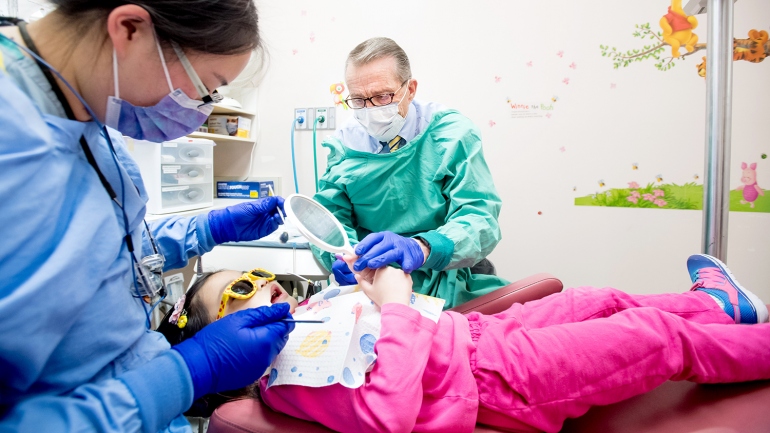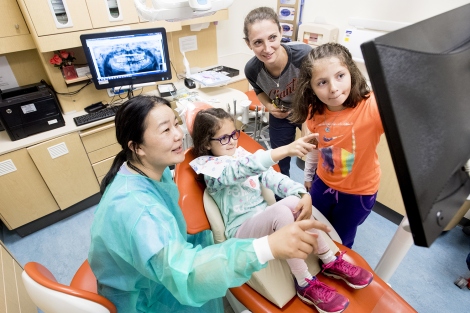UCSF Dentists are Teaching Peers to Treat Babies – Filling a Gap in Care
New Bay Area Program Aims to Improve the Oral Health of Kids at High Risk for Dental Disease

Babies and toddlers may not have many teeth, but they still need regular dental exams.
“By the time teeth emerge in babies, the groundwork has already been laid for their lifetimes of dental health,” said Ray Stewart, DMD, MS, a professor of orofacial sciences at UC San Francisco.
The American Academy of Pediatric Dentistry recommends that babies should have their first dental exam when they get their first tooth and no later than their first birthday.
Tooth decay is the most common chronic infectious diseases in the United States. By age five, more than a quarter of young children suffer from tooth decay, a figure that is five times more common than childhood asthma.
By the time teeth emerge in babies, the groundwork has already been laid for their lifetimes of dental health.
Professor of orofacial sciences at UCSF
Seeing kids before the decay process has begun – even before they have any teeth yet – provides an opportunity to inform the parents or caretakers to implement good oral hygiene and good dietary practices, such as reducing the amount and frequency of sugary and starchy food and drinks.
Any opportunity to prevent tooth decay early is lost, however, if the kids aren’t getting to dentists who treat young children.
And not all dentists will see young children, since there are a host of considerations that aren’t present in older children in or adults, including the youngsters being able to sit still in the chair for an examination.
To help general dentists become comfortable seeing very young patients, Stewart and other UCSF pediatric dentists are part of the Dental Transformation Initiative in California. They are developing a curriculum to train nearly 50 general dentists in Alameda county to see and treat young children. This program launched in November, with a similar program beginning in San Francisco in the next few months.
The initiative also links each trained provider with a community care coordinator, who will serve as a liaison between the families of young patients and the dental offices to ensure that appointments and follow-up visits are kept and help establish continuity of care.
The focus is on improving the oral health of children at greatest risk for dental disease. “We are emphasizing early prevention and intervention,” said Stewart.
New Learnings About Old Problems
Part of current pediatric dental care comes from new understandings about problems that have existed for some time. For example, what used to be considered “baby bottle tooth decay” from sweet liquids clinging to an infant’s teeth is now also known to be related to the caregiver’s dental health, through transmission of their oral bacteria, said Stewart.

As soon as teeth emerge, they are exposed to bacteria in the mouth. Some types of oral bacteria thrive on sugars and starches in the mouth and produce acid, which destroys the enamel and dentin (the outermost layers) of teeth. Dental caries, commonly called cavities, is the process that is started by bacteria and that ends in tooth decay.
“We see young kids at 12 or 18 months of age, who might only have a few teeth but already have a mouthful of cavity-causing bacteria,” he said.
From birth to three years old is a critical time for the decay-causing bacteria to colonize in children’s mouths. If the problematic bacteria can be staved off until children are four years old or older, children will be up to five times less likely to get cavities for the rest of their lives than those who acquired it at a younger age, said pediatric dentist Ling Zhan, DDS, PhD, an associate professor of orofacial sciences. Children can get those bacteria from family members, caregivers and playmates who have/had cavities.
New dental prevention protocols, such as the use of silver diamine fluoride as a “rescue drug,” may buy some time for young children, Zhan said. It can slow down the decay process such that the child isn’t exposed to infection and can wait to be treated until old enough to sit still in a chair.
Stopping Small Problems Before They Grow
The inability of the youngest of dental patients to sit still in a chair is a problem of its own. Very young children are unable to sit still for even simple dental procedures and must be put under anesthesia.
Anesthetizing infants and toddlers is best avoided, Stewart said, primarily because of an increased risk for delayed development of cognitive skills.
The pediatric dental program at UCSF sees an average of 20 to 25 young patients per week who must be put under general anesthesia – after an approximate five-month wait and at a cost of approximately $10,000 for dental procedures under general anesthesia.
A specific goal of the Dental Training Initiative, said Stewart, is reducing the number of children who are treated in the hospital operating room under general anesthesia and to put off the exposure to general anesthesia until after age three for those children requiring such care.
“Even beyond anesthesia concerns, the real issue is the long-term repercussions of early dental problems for children as they grow into adolescence and adulthood,” he said. “All of their permanent teeth are going to have the exact same problems as the baby teeth did.”
Adding fuel to the flame, he added, is that there is also a clear link between oral health and major health problems in adulthood, including cardiac disease and risk for diabetes and stroke.
Decades of Teaching About Pediatric Dentistry
Stewart has been working for decades on including pediatricians in the process of oral health. He has taught them how to identify children at high risk for dental caries, refer them to dentists, and use simple strategies to prevent decay process from getting started. For example, he has trained pediatricians to use one-year well baby visits as an opportunity to apply fluoride varnish, which was shown in a 2006 UCSF study to reduce decay in very young children.
Beyond dentists and pediatricians, Zhan said an overall goal of theirs is to include a wide swath of interdisciplinary involvement. UCSF has explored programs to include oral health education program for nutritionists, obstetricians and pregnant women on the importance of their own oral health for their children’s futures. UCSF pediatric dentistry also has reached out to oncology and transplant clinics to convey the connection between oral health and serious complications, such as blood bacteria infection from oral origin, as well as setting protocol of dental screening and home care guidelines to prevent rampant tooth decay that can occur within months in cancer patients receiving chemotherapy and/or radiation therapy.
“We want to get it before the damage is done,” she said. “Tooth decay is a totally preventable thing if you have the knowledge.”